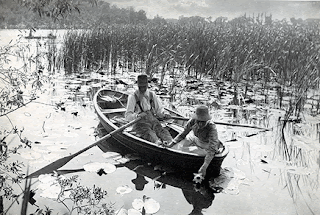Joseph Wright of Derby photographed images which showed someone lecturing, showing a hierarchy of learning. The light used is a metaphor for hope, knowledge and awareness.
Photography was born in an era of classicism, which harked back to an Ancient Greek and Roman sources. The enlightenment took empiricism as it’s drive. The Age of Reason rejected the supernatural and focused instead on nature as experience by humans (humanism) which enabled closer measurement and experimental repetition which provided proof.
Georg Brander invented the Table Camera Obscura, which literally means the dark room. This involves the camera in it’s basic form. The camera obscura has a 50mm lens, the same as our eyes. These images are like looking through a wide angle lens.
-
The tamishing of silver had been observed since ancient times and Arabian alchemists.
- 1727 German scientist Johannes observed that silver salts darken when exposed to the sun.
- 1777 Scheele, a Swedish chemist discovered that Silver Nitrate darkens quickest with blue light.
- 1802 Josiah Wedgewood reports success at producing images on leather which had been impregnated with silver salts.
1825 - experiments with photography.
1839 – birth of photography.
Joseph Nicéphore Niépce took the first photographic image that we know of. This was printed onto a piece of metal. ‘View from the window at Le Gras’ – 1826
Joseph Nicéphore Niépce gave his invention to Louis Jacques Mandé Daguerre (1787-1851) and he created the daguerreotype in 1839.
The stages of making a daguerreotype portrait
1 - An assistant polishes a silver-coated copper plate with a long buffer until the surface is highly reflective. The highly polished plate is then taken into the darkroom, where it is sensitized with chemicals ( e.g. chloride of iodine, chloride of bromine ).
2 - The operator places the sensitized plate into a camera placed on a high shelf (z). When the sitter is ready the operator removes the camera cover and times the required exposure with a watch. [ In this illustration, the operator is using Wolcott's Mirror Camera, which was fitted with a curved mirror instead of a lens ].
3 - The exposed plate is returned to the darkroom where the photographic image on the silvered plate is "brought out" with the fumes from heated mercury. The photographic image is "fixed" by bathing the plate in hyposulphate of soda. The photographic plate with the daguerreotype image is then washed in distilled water and dried.
4- Finally, the finished daguerreotype portrait is covered by a sheet of protective glass and is either mounted in a decorative frame or presented in a leather-bound case and offered to the customer for close inspection. Early daguerreotype portraits were very small and to appreciate the fine detail these customers are using a magnifying glass.
William Henry Fox Talbot (1800-1877) created the Kalotype method shortly after.
The stages of making a kalotype portrait
Iodise the Paper
1 - Find a suitable paper.
2 - Brush onto the paper an 8% solution of silver nitrate in distilled water. Allow the paper to become matt dry.
3 - Immerse the paper in a solution of potassium iodide 2 to 3 minutes. Then wash the paper for several hours under running water.
4 - Dry the paper, then hang it for up to two hours in sunlight. This will help the paper to produce a more contrasty image. At this stage, the paper has a coating of silver iodide, which is insoluble and insensitive to light. This paper should be stored in an acid-free box until ready to use in the camera.
Sensitise the Paper
5 - Under a red light, coat the iodised paper with an silver nitrate in distilled water. Other chemicals are also required at this stage. I believe that these include glacial acetic acid and gallic acid. Blot the paper to remove excess liquid, then cut to size for the camera.
Expose the Paper
6 - While the sensitised paper is still wet, expose it in the camera. A two minute exposure at f8 may be required on a sunny day.
Developing
7 - Brush a solution of silver nitrate (similar to the sensitising solution but stronger) over the paper, followed by gallic acid. [Possibly also use acetic acid.] The image should appear, perhaps in half an hour, or 3 to 4 hours on a cold day. The image is ready when it shows a good contrast, viewed in red light.
Fixing
8 - Wash the paper, then fix in potassium bromide or hypo to create the calotype negative. Initially, iodides were used for fixing. Talbot initially fixed his image using a solution of potassium bromide. Wash the paper, then dry.











































